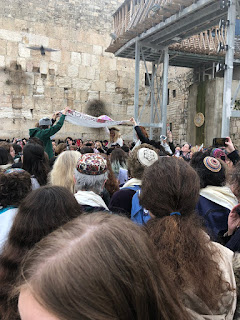I know this is a little late, but hey, better late than never. Last week we took a trip to the famous Israel Museum in Jerusalem. Not only do we see breathtaking beauty in the many exhibits and statues, but we can learn so much from them. From taking a second to look at the sky, hear the birds, and breathe, to seeing actual and replicas of the original Dead Sea scrolls. One of my personal favorites was the room with the open roof, and looked much like a painting (as you see on the right). Sadly, my assignment is to talk about the Jews in the Roman period instead of how amazing the Israel Museum was aside from the education. So, I guess I have to dive into that.


The Jews in the Roman period were a diverse group to say the least, and much like today they ranged on a wide spectrum of their Judaism. Some believing that it was more important than all else to retain Judaism and all of its traditions, and others thought that maybe a little bit of assimilation wasn't all that bad. This resulted in a lot of dilemmas that coming up for the Jews. On one hand, the Romans were treating them fairly well, and it wouldn't be smart to taint that relationship considering they ran the place. But on the other hand, that might mean having to leave behind some Jewish traditions and laws to maintain a healthy relationship with them. Like in class, we were given a dilemma of what to do when invited to a party by an authority figure on Shabbat. It would be rude to say no, but it's the Sabbath and there would definitely be non-Kosher food there. Even though that is just an example in class, there were most likely situations just like it. So, some Jews kept their culture, and didn't assimilate with the Romans. Others, said to heck with Judaism, I want a good life here. This resulted in the creation of four major sects in Judea at the time.

But before we get to that, what about Jerusalem itself? The actual city of the Jewish people. The most important site to our religion. Surely that stayed Jewish right? Kinda. Plenty of buildings were influenced by Roman architecture. Even at the temple, we can see columns (which are Roman). In the surrounding area of Judea, many houses are based off of Roman architecture, and the more Roman they are, the bigger they get. From this model we can see what the old city looked like during the Roman period (basically). Every time there is a new discovery about a building in the time period, it's added to the model. While it isn't an exact replica of the actual city, it is the closest thing that there is to what the old city looked like.

Back to the four sects formed during this period, the Pharisees, Essenes, Sadducees, and Zealots. The Pharisees being the lower-class rabbis that didn't like the Romans. The Essenes being those who moved out near the Dead Sea in waiting of the messiah and were obsessed with cleanliness. The Sadducees being the priests who only believed in the written law of the Torah, and were friends with the Romans. Finally the Zealots were the extreme Jews who hated Roman rule and would kill them and any Jew who wasn't with them. As you can see, the groups have a wide range of Jewishness and beliefs. Much like today, with all the different sects of Judaism. Personally, I'm not sure which sect I would identify with the most, considering that all of them have some extreme flaws. I guess I would have to go with the Pharisees because I wouldn't like Roman rule, but I wouldn't cause a war amongst the people.
The question that I want to leave with you is, which sect of Judaism in this time do you identify with the most? What relations to your life do you see in that sect?

























